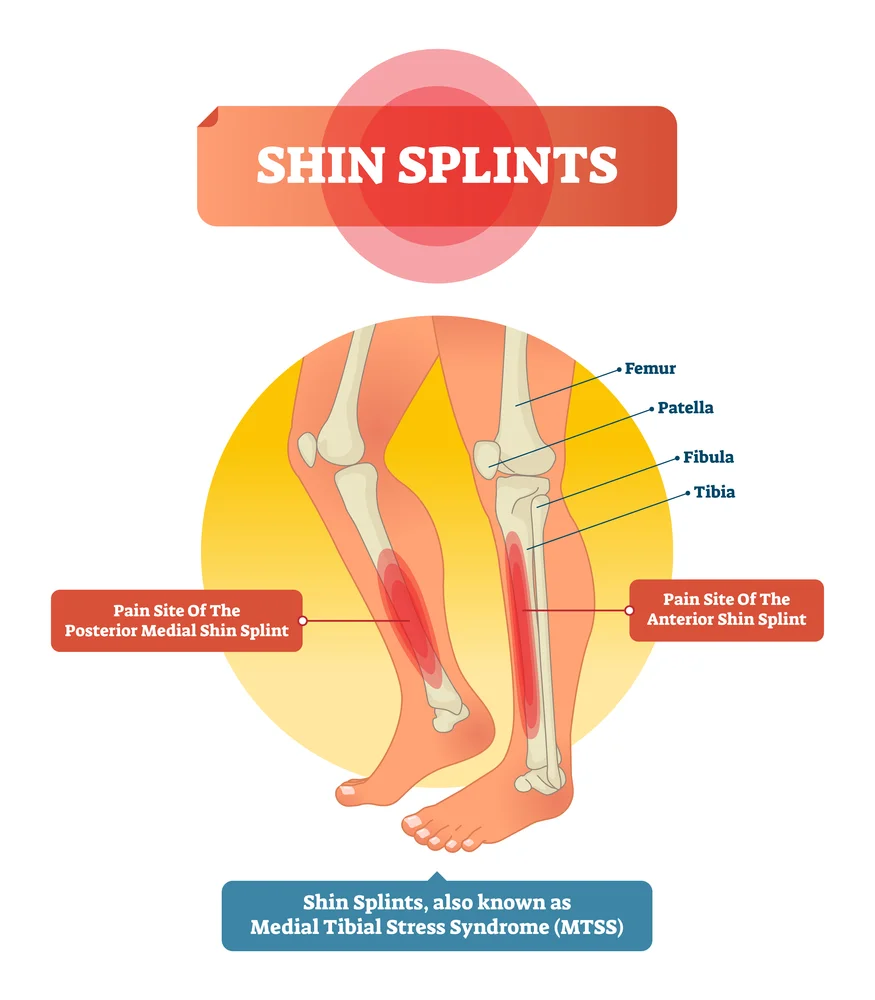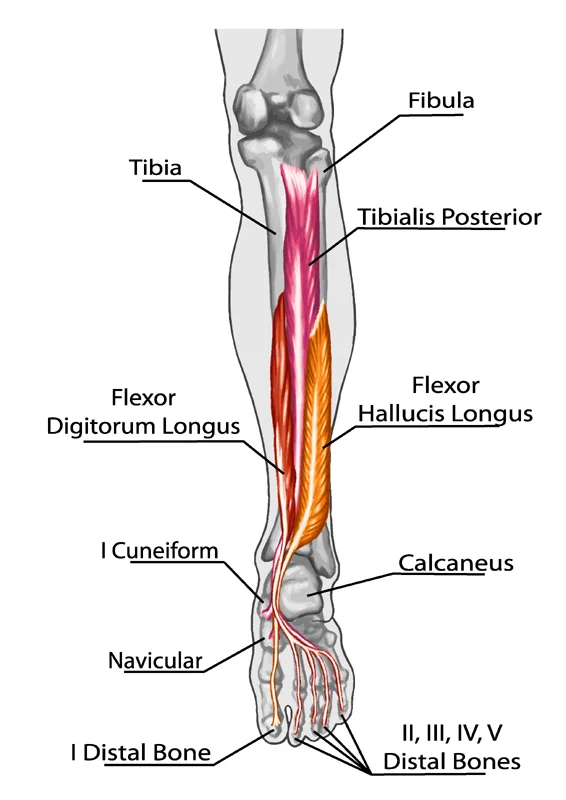Springtime is here! The weather is warming up, the sun is starting to shine on those early morning runs, and we can finally shed many of those heavy layers of clothes for our preferred running shorts and singlet top!
But…spring time also means something else for runners.
For most runners, it means it is time to come out of the pain cave, get off the globogym cardio theater dreadmill, and start hitting the roads again. For some, it means it is time to come out of hibernation and begin training again. While this all seems well and good, the road can cause some aches and pains that the somewhat forgiving treadmill or cushy couch hid from you all winter long.
You know what I am talking about. That all too familiar pain down the inside of shin bone that can also sometimes radiate into the foot and seems to intensify with every run. Road running in the spring can be wonderful, but it can also be painful. The road is an unforgiving surface (part of the reason our treatment plans include running on a track or trail) that can bring even a veteran runner to their knees in frustrating agony with each run.
Yes, I’m talking about Shin Splints!
Today we are beginning our Shin Splint Relief & Prevention series by discussing what ‘shin splints’ are, how they occur, who is more likely to experience shin splints, as well as a few other complicating factors. We will follow this up with self-care in Part 2, and Treatment & Rehabilitation options in Part 3.
WHAT ARE SHIN SPLINTS: MEDIAL TIBIAL STRESS SYNDROME
From an anatomical perspective, shin splints are a condition where there is pain, tenderness, and sometimes swelling along the middle, inside of the tibia (shin) bone. While the cause is debated as to whether this pain comes from a muscle and tendon response to doing too much too soon, the tibia bones inability to handle the stress and pounding from running, or damage to the connective tissue that wraps and supports all of these structures in the lower leg and foot.
The hallmark sign of Shin Splints is the extreme tenderness along the inside of the shin that seems to improve as a runner warms up, but begins to worsen, last longer, and eventually prevent running as time passes without care. From this, this condition is more aptly named Medial Tibial Stress Syndrome.
Before we discuss why this condition plagues runners, and what we in the medical community think is actually happening, let’s look at the important anatomy involved.
WHY RUNNERS & WHAT FACTORS LEAD TO SHIN SPLINTS
Running injury statistics are horrifying, with studies estimating that anywhere from 40-80% of runners experience an injury EVERY YEAR. I am not going to bother trying to track down the actual number because it changes montlhy as new research comes out, but the fact is that as runners, we run a high risk of injury. From that, it is estimated that 1 in 5 are dealing with shin splints. Since this is such great news, let’s look at some reasons why this injury is so common and who could be at higher risk.
New Runners - If you are truly new to running, Shin Splints are almost a right of passage. In the process of your body adapting to this new stress, figuring out your form, and slowly increasing your mileage, your body will get to the point where it starts to scream…’why are you doing this to me’. As we progress through this series, you will find ways to build up your body, more specifically your legs, so that it can handle this new stress of running.
Running Biomechanics - The Tibia bone is believed to absorb 2-3x’s your body weight with each step. Take into account that the average runner has a cadence (steps per minute) of 140-180, it is no wonder we begin breaking down at the tibia.
Higher BMI/Body Weight - Looking at the last statement, if you have higher body weight, and you are new to running, forcing your tibia to withstand the pounding from running should be a slow process with ample recovery.
Training Volume - Just like new runners, if you are a veteran with a solid training base of 30-35 miles per week and you sharply bump up to 55-60 miles per week, you are essentially treating your body like a newbie with a very unfamiliar stress.
SIMILAR PROBLEM: Too Much Too Soon & Classic Overtraining
Form - Forefoot, Midfoot, or Heel Striker, you efficiency within that form and allowance for adaptation to stress is what either prevents or causes injury. I have seen all forms present with shin splints, and it is usually a combination of the above causes.
WHAT ACTUALLY CAUSES SHIN SPLINTS
While the cause of Medial Tibial Stress Syndrome is still debated, with research naming a different cause. It is likely a combination of the factors we are going to cover. This is why, if you have been suffering from shin splints for a month or so and are just trying to run through them, it is important to get an evaluation, a structured plan around your goals, and some treatment to get you over the hump.
Weak Ankle Dorsiflexion - Loss of eccentric control.
One issue that many believe to be a cause, or at least a contributor to shin splints is poor control of the anterior leg muscles, or weakness of the Tibialis Anterior muscle. This one stands out in newer runners because it is responsible for the slapping sound one makes when their foot hits the ground. This comes from weak eccentric control of the muscle, or the ability to slowly let it down to the ground. Our bodies are amazing, so when one area fails, another area takes the load…
Poor Pronation Control & Tight Posterior Tibialis Muscle
Lets first start by reminding everyone that pronation is a normal part of the gait cycle, but poor control of the speed of pronation can cause problems. If we have excessive tightness through the posterior tibialis muscles, either due to overuse or poor adaptation to load, it is unable to respond well enough when the foot hits the ground, causing the foot to crash in during pronation. If this is the case, we see each step pulling on this already tightened muscle, as well as the facia that wraps it and attached to the inside of the tibia bone (that spot where you are tender), inflaming the area, damaging the muscle, and leading to poor mechanics while running.
Bowing of the Tibia Bone
To further the case of this mid-shin bone pain where the posterior tibial muscle lies, we have data that shows the Tibia bone actually bowing during running. While our bodies are adaptive and resilient, we believe this bowing to be minimal, undetectable without fancy equipment, but a natural part of our body handling the forces the road gives back with each step. Where this comes in to play is with a young or new-to-running runner who decides to run through their pain. If this goes on long enough, and the runner overtrains, this can lead to a stress fracture injury.
Over Training - Too Much Too Soon
This is probably the most common reason runners experience shin splints, and most other injuries for that matter. Over-training is the common factor of the 3 potential causes we mentioned above. As a new runner or an experienced one looking to increase mileage, a plan that not only includes a structured running plan, but strength training, cross training, and rest must be considered.
SUMMARY
Shins Splints are most known to cause pain along the inner edge of the tibia bone that is tender to the touch. Swelling may or may not be present.
While many causes are debated, one thing holds true. Whether you are a new runner or a veteran. Doing too much too soon will likely lead injury.
Runners are most at risk due to the repetitive nature of running. Add in volume changes, the pounding of the road, lack of self-care and warming up before each run..it all adds up.
Dr. Reheisse is a Board Certified Chiropractic Sports Physician practicing in Cottonwood Heights Utah. Revive Sport & Spine provides evidence-supported chiropractic care and conservative sports injury management.




